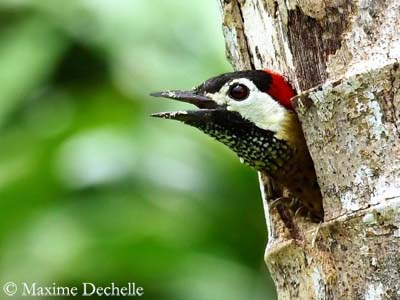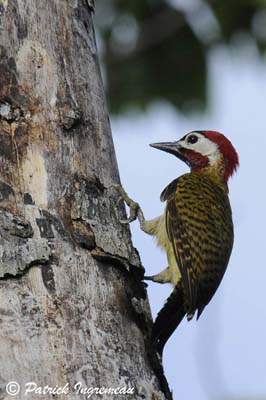
Spot-breasted Woodpecker
Colaptes punctigula
Piciforme Order – Picidae Family
BIOMETRICS:
Length: 18-21 cm; Weight: 50-70 gr
DESCRIPTION:
The Spot-breasted Woodpecker is a bright coloured woodpecker, living mainly in tropical areas of northern South America.

The adult male has bronze green upperparts with regular blackish bars, including on the wings. The flight feathers are dark brown with paler bars, and we can see yellow narrow patches forming a panel visible in flight. The rump is less marked and paler. The uppertail feathers are dark brown with the outer rectrices barred green and yellow.
On the underparts, plumage is rather pale yellow-olive, but the upper breast is tinged reddish-orange, turning paler on belly. The breast shows tiny black spots. Flanks are very slightly spotted. Undertail coverts are yellowish with black spots. The undertail feathers are yellow-brown and barred brown. The underwing is pale yellowish.
The Spot-breasted Woodpecker performs some courtship displays, very similar to their aggressive behaviour. The male usually erects the feathers of crown and nape, and performs several swinging movements of head and body, and also head-bobbing. All the displays include spread tail, and sometimes dropping wings.
Woodpeckers are diurnal birds, leaving the roost at dawn. The roost is an excavated hole, and the same tree may contain several holes.
It is sedentary within its range.
DIET:
The Spot-breasted Woodpecker feeds mainly on ants, found in trees by gleaning and probing, or on the ground by probing into the soil and the leaf litter.
PROTECTION / THREATS / STATUS:
The Spot-breasted Woodpecker is fairly common in its range, except in Panama where the species is rare.
But the result of deforestation involves some increasing of populations in several regions, with creation of clearings and less densely wooded areas.
Fr: Pic de Cayenne
All: Tüpfelbrustspecht
Esp: Carpintero Moteado
Ital : Picchio della Cayenna
Nd : Vlekborst-grondspecht
Photographers
Patrick Ingremeau
His website: TAMANDUA
Maxime Dechelle
His website: LEPAPARAZZO
Marc Chrétien
His website : MURINUS
Text by Nicole Bouglouan
Sources:
HANDBOOK OF THE BIRDS OF THE WORLD Vol. 7 by Josep del Hoyo-Andrew Elliott-Jordi Sargatal – Lynx Edicions – ISBN: 8487334377
A GUIDE TO THE BIRDS OF COLOMBIA by Steven L. Hilty and William L. Brown
Princeton University Press – ISBN 069108372X
On the head, colours are contrasted. Forehead and forecrown are black, whereas the hindcrown and nape are red. Sometimes, the red colour may extend forwards or over the whole crown.
A conspicuous white patch extends from lores, above and below the eye, through ear-coverts until the neck side. The malar stripe is red. Chin and throat are black, finely spotted black and white.
The bill is rather short, pointed and blackish. The eyes are rufous-brown. Legs and feet are pale greenish-yellow.
The female lacks the red malar stripe and the red patch of the crown is more restricted, only to rear crown and nape.
The juvenile resembles adults, but it has duller and greener plumage above. Underparts are duller too, with larger spots. The young male shows some red in the malar area.
The Spot-breasted Woodpecker has six subspecies with some variations of intensity in colours and extension of head colours patches. There also are some differences in size. The race “punctigula” of the Guianas is the smallest.
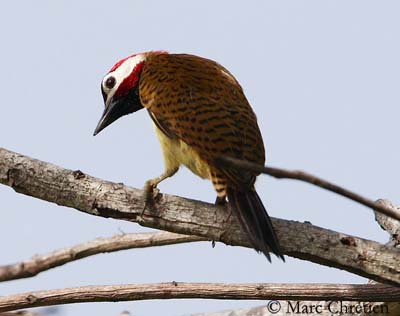
VOICE: SOUNDS BY XENO-CANTO
The Spot-breasted Woodpecker utters weak, nasal “wha-whe-whe…wha” high-pitched. When threatened, it gives series of “peek” notes. Courtship displays are accompanied by whistled “whew” and the changes at nest by low, soft “pee-ya”.
The Spot-breasted Woodpecker utters several kinds of sounds often given in series.
This species probably produces drumming as most of the Picidae, but there is not available information.
HABITAT:
The Spot-breasted Woodpecker prefers open woodlands and edges, rainforest, mangroves, swamp edges, llanos, cultivated areas with trees, moist lowland forest.
It frequents varied habitats but avoids the dense forest. It may be seen at different elevations, according to the country, from 600 metres up to 1600 metres. It is mainly a bird of the humid woodlands.
RANGE:
The Spot-breasted Woodpecker lives in northern South America, in Bolivia, Brazil, Peru, Colombia, Ecuador, French Guiana, Suriname, Venezuela, and also in eastern Panama.
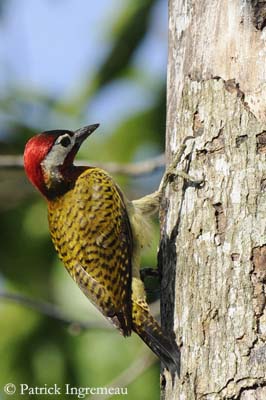
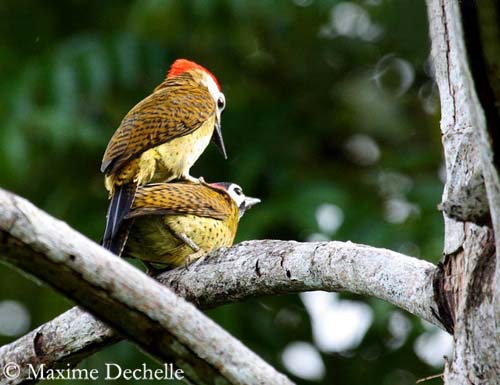
FLIGHT:
The Spot-breasted Woodpecker performs undulating flight, typical in Picidae.
REPRODUCTION:
Breeding season varies according to the country.
The Spot-breasted Woodpecker nests in holes excavated by both adults in trees.
There is not information about the nesting behaviour of this species.
